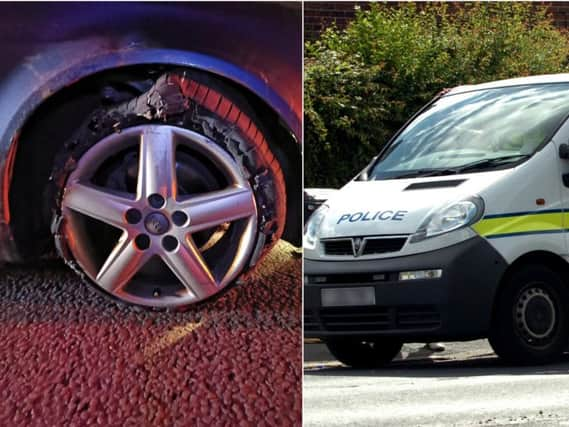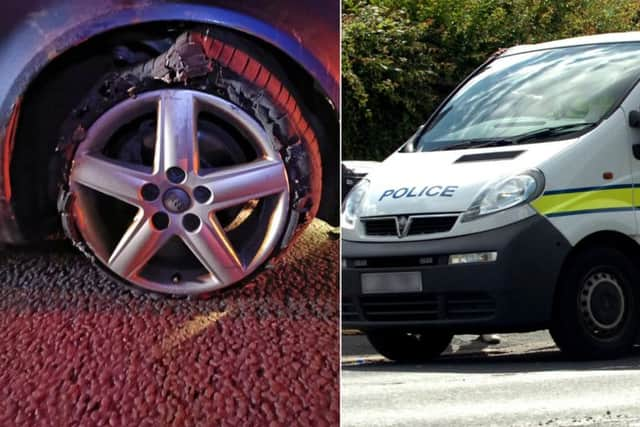Shocking wheel condition discovered on Audi travelling from Bradford to Halifax


West Yorkshire Police's Road Policing Unit pulled over the driver of the Audi on August 1.
Commenting on their Twitter account the RPU said: "It may be 2.30am but to drive from Bradford to Halifax with this is appalling.
Advertisement
Hide AdAdvertisement
Hide Ad"Checking your legal tyre tread depth is one of the most important checks you can make on your car."


Here the RAC explains the law about tyre conditions and tread depth
What is the legal tyre tread depth?
The legal tyre tread depth for cars in the UK and Europe is 1.6mm across the central three-quarters of the tyre, according to law.
The tread must meet this minimum requirement across its complete circumference.
What is the expert-recommended minimum tyre tread depth?
Advertisement
Hide AdAdvertisement
Hide AdTyre and safety experts believe the 1.6mm legal minimum is insufficient to guarantee safety – most recommend a minimum tread depth of 3mm for tyre replacement.
Tests by UK technical organisation MIRA found that, once tyres are below 3mm, stopping distances increase dramatically.
The difference in wet braking distance between a tyre worn to 3mm and one worn to 1.6mm can be as much as 44%.
Worn tyres are particularly dangerous in the wet because a tyre’s tread helps disperse water away from the contact patch between tyre and road.
Advertisement
Hide AdAdvertisement
Hide AdIf there’s less tread depth, less water can be shifted, increasing the risk of aquaplaning and losing grip.
In heavy rain, each tyre can shift one gallon of water every second, illustrating just how hard tyres work.
Simply put, deeper tread means they can work better, improving grip.
How to check tyres are in a roadworthy condition - RAC expert tips
Advertisement
Hide AdAdvertisement
Hide AdTyre tread depth has to be above 1.6mm to be legal. This must be the case for the middle three quarters of the tyre.
There are three ways to check this:
How to check tyre tread depth – the 20p test
The 20p test is a simple, quick and easy way of checking the tyre tread of your car's wheels.
Just take a 20p coin and insert it into the tread grooves on the tyre.
If you can't see the outer band on the coin, your tyres are above the legal limit.
Advertisement
Hide AdAdvertisement
Hide AdHowever, if you can see the band and that section of the coin is still visible, your tyres could be unsafe and require professional inspection by a mechanic.
We suggest drivers conduct the 20p test around every two weeks and before long journeys.
Checking tyre tread with tyre tread wear indicators
If the tyre is flush with these, it is below the legal limit and needs replacing.
Checking tyre tread with a tyre tread depth gauge
These are purpose made tools that quickly measure the depth of an individual tyre groove. These are available from our online store:
What happens if you have an accident on illegal/bald tyres?
Advertisement
Hide AdAdvertisement
Hide AdDriving with tyres that have a tread below the legal limit - or even worse, are bald - is dangerous.
It can put you and other motorists at risk.
If you are involved in an accident and the car you are driving has illegal or bald tyres, you should be aware of the consequences.
Any insurance claim as a result of an accident could be invalidated, so potentially your insurer won't pay out any money any repairs needed to your vehicle.
However, driving with dangerous or defective tyres also puts drivers at risk of a fine of up to £2,500 and three points on their license.
Advertisement
Hide AdAdvertisement
Hide AdThat is per tyre, so four illegal tyres could mean a fine of £10,000 and 12 penalty points.
You can buy tyre tread gauges that help you assess the tread depth of the tyre, plus you can also get more basic colour-coded tools that let you know if a tyre is legal or not at a glance.